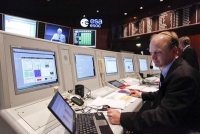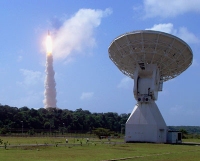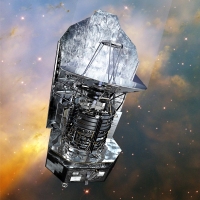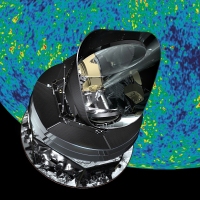Herschel and Planck commissioning has begun
20 May 2009
After a perfect injection by the Ariane 5 launcher on 14 May, the critical Launch and Early Orbit Phase (LEOP) for Herschel and Planck has started to wind down, while commissioning of the scientific instruments and subsystems on both spacecraft has begun.
 |
|
Main Control Room (MCR) at ESOC during the launch |
 |
|
Ariane 5 V188 rises above ESA's Kourou tracking station |
The additional ground stations that enabled near-continuous contact between mission controllers and Herschel and Planck during LEOP have been released; the two are now communicating via their nominally assigned stations, ESA's New Norcia and Cebreros deep space stations, respectively.
Shortly after launch, both spacecraft separated according to plan: Herschel at 15:37:55 CEST followed by Planck at 15:40:25 CEST. This triggered the execution of automatic sequences on board, including acquisition of the spacecraft's orientation in space, configuration of the data handling system and switch-on of the high-frequency radio transmitters.
The first signals from both spacecraft were acquired by ESA's New Norcia and Perth stations at 15:49 CEST. Shortly afterwards, telemetry was received confirming good health for both spacecraft. Both had acquired their nominal sun-pointing attitude and a telemetry check-out performed by the Mission Control Team confirmed their overall status as nominal.
Critical LEOP phase winding down
 |
|
Planck and Herschel en route to L2 |
The excellent injection provided by Ariane 5 into L2 transfer orbit means that only moderate trajectory correction manoeuvres (TCMs) - during which the thrusters are fired to change the spacecraft's direction or speed - will be required giving ground controllers a larger margin of fuel for the scientific part of the mission.
On 15 May, both spacecraft successfully completed their first TCMs: TCM 1a for Herschel providing a change in speed of 8.7 ms-1 at 15:16:26 CEST, and TCM 1a for Planck providing a change in speed of 14.35 ms-1 at 20:01:05 CEST.
Subsystem commissioning began on 15 May for both satellites, and telescope and payload module cool-down started in parallel on both spacecraft.
Herschel
 |
|
Artist's impression of Herschel |
Commissioning of the spacecraft's service module began on 15 May.
As planned, Herschel switched to reduced ground station coverage of 10 hrs/day on 16 May. This will continue until two weeks after the launch for the initial commissioning activities. All of the satellite's subsystems have shown nominal performance, and commissioning continues.
A touch-up manoeuvre was executed on 18 May at 19:00 CEST, providing a modest change in speed of 0.99 ms-1.
Planck
 |
|
Artist's impression of Planck |
The following manoeuvres will be the mid-course correction (TCM 2) and the insertion manoeuvre (TCM 3), scheduled for 5 June and 2 July at 19:00 CEST, respectively.
Another major milestone was completed with the commissioning of the 'large' slew capability. These slews, a few arc minutes in magnitude, are executed with small (1N) thrusters; they are large compared to the requirement for the mission. These large slews are necessary for Planck to follow its scanning strategy and recover fine control after monthly orbit maintenance manoeuvres performed with the bigger (20N) thrusters.
The HFI instrument has also been switched on and is fully functional. HFI is now waiting for the rest of the cooling chain to be switched on and to cool to its final operational temperature.
All of the satellite's subsystems have been commissioned normally and ground station performance is nominal.
En route to L2
By 21:00 CEST on 19 May, Herschel and Planck were located 617 287 km and 607 767 km, respectively, from the Earth, approximately 1.6 times farther than the Moon's average distance of 384 403 km. The two sister satellites were separated by 9917.35 km.
(Originally published on www.esa.int)
